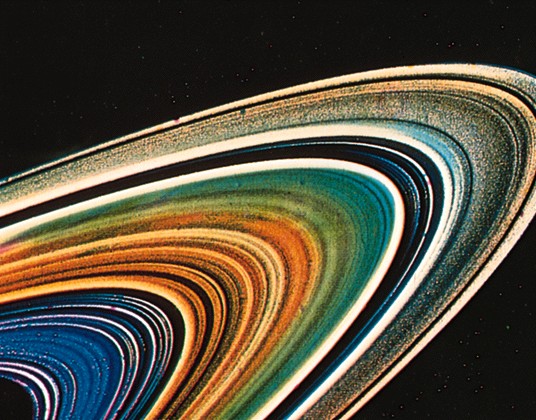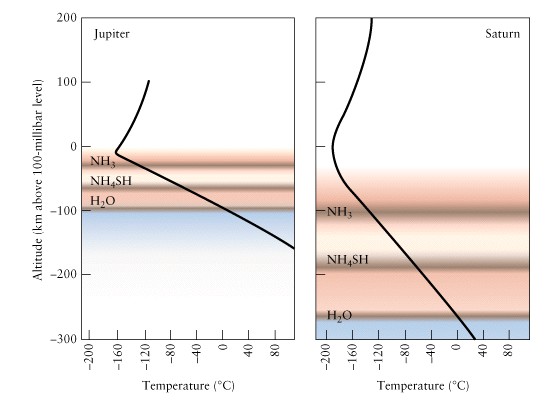Chapter 15 Question
2. Structure of Saturn's rings
Saturn's rings are
made up of millions of individual pieces of ice (or ice covered rock) that
range in size from 1 cm to 5 m. The average size of 10 cm would make
a good snowball. These pieces of ice are in turn organized into ringlets
by gravitational effects of Saturn and its moons (see figure). Because
each ringlet has a color that is distinct from its neighbor, it seems unlikely
that the material in the ringlets migrates substantially in the radial
direction.

Chapter 15 Question
6. Compare atmospheres of Saturn and Jupiter.
Being gas giants,
the atmospheres of Saturn and Jupiter are at first glance very similar,
however, there are some subtle differences between them. First, Saturn's
outer atmosphere of molecular hydrogen appears to be much deeper than Jupiter's.
This is evidenced by Saturn's more oblate shape. Saturn's the deeper
atmosphere contributes to its low average density. The manifestation
of Saturn's lower density in the topmost regions of its atmosphere is a
larger spacing between cloud layers, relative to Jupiter. This is
why it is harder to see deep into Saturn's upper atmosphere and it appears
more washed out than Jupiter. Another important difference between
Jupiter and Saturn's atmospheres is the difference in their helium content.
Jupiter's helium content (relative to hydrogen) is very similar to the
Sun's. Saturn's helium content is significantly lower. The
reason for this is unknown, but one theory is that Saturn's helium condensed
in the form of rain and sank to lower regions of the atmosphere.
This raining process may have also contributed to Saturn's unexpectedly
large internal heat output.

Chapter 15 Question
12. Titan's atmosphere.
Titan the thickest
atmosphere of any moon in the solar system. The atmosphere probably
started out as ammonia (NH3), but in a process similar to the
breaking up of molecules in other atmosphere's, UV sunlight split the ammonia
into nitrogen and hydrogen. Being light, the hydrogen can escape
Titan's gravitational pull, which has left Titan with a predominantly nitrogen
atmosphere. Titan also has a lot of methane in its atmosphere.
Methane and sunlight interact to form complex hydrocarbon, like ethane,
acetylene, and ethylene. The ethane produced in these reactions may
have rained down on the surface of Titan in such quantities as to produce
rivers and lakes! Hopefully the Huygens probe, due to arrive
in 2004, will give us a better view of Titan's surface.
Chapter 16 Question
5. Colors of the outer planets
[Optional background]
For reasons which aren't exactly known, Uranus and Neptune have proportionally
more heavy elements than Jupiter and Saturn. One theory is that Uranus
and Neptune were formed closer to the Sun (where heavy elements condensed
in greater abundance) and then were moved by to their larger orbits by
gravitational interactions with Jupiter. Alternately, Uranus and
Neptune formed a little later than Jupiter and Saturn, when some of the
lighter elements had already been swept away by the solar wind. [Now
to answer the question] Methane is one of the compounds present in
the atmospheres of Uranus and Neptune in much greater quantities than found
on Jupiter and Saturn. Methane preferentially absorbs red light,
leaving only blue light to reflect from Uranus and Neptune. We are
not exactly sure what causes the colors in Jupiter and Saturn's clouds,
since the major constituents should all be white in color. However,
since the clouds are white, whatever other colors there may be can show
through more easily.
Chapter 16 Question
12. Triton captured by Neptune?
The fact that Triton
has a retrograde orbit is the most convincing evidence that it was captured
by Neptune. Also, though it is now in a circular orbit and does not
currently experience much tidal force, it has a relatively new surface,
suggesting that internal heat was generated not long ago. A likely
source of heat would be tidal forces experienced in its initial capture
orbit, which was probably highly elliptical.
Chapter 16 Question
15. Pluto as a Kuiper belt object.
The retrograde rotation
of pluto, its high inclination and eccentricity, as well as its distinct
composition (as evidenced by its intermediate average density) all suggest
that Pluto is in a class of objects distinct from the major planets.
Such a class of objects was proposed by Gerard Kuiper in 1951 to explain
the source of short period comets. These objects are probably left
over icy planetesimals from the protoplanetary disk that never collided
with a major planet.
Chapter 17 Question
11. Ion and dust tails
The ion and dust
tails of comets point in different directions because different physical
effects act on them. The ion tail is is pushed back by interaction
with the solar wind. The dust tail is pushed back by radiation pressure.
The solar wind is much more effective at moving ions than solar photons
at moving dust. Therefore, the ion tail sticks back straighter from
the comet head.
Chapter 17 Question
13. The Kuiper belt.
The Kuiper belt
is a disk-shaped distribution of icy planetesimals that orbit the Sun with
semi-major axes greater than that of Pluto. Kuiper belt objects are
like asteroids in that they never coalesced to form a planet, but they
are primarily made of ice instead of rock.
Chapter 17 Question
14. The Oort cloud
The Oort cloud is
a spherical cloud of icy planetesimals with very large orbits. The
Oort cloud was proposed in 1950 to explain long period comets, in particular
why long period comets don't have a preference for appearing in the ecliptic,
like most other solar system objects. The Oort cloud is probably
made up of planetesimals that were ejected in random directions by gravitational
interaction with the planets (particularly the Jovian planets).
Chapter 30 Question 2. Playing with the Drake Equation
N = Rs fp ne fl fi fc L
A nice way to solve this problem is to solve the Drake equation for L:
L = N / [Rs fp ne fl fi fc]
| Variable | Book Value | Alternate value (a) | Alternate value (b) |
| Rs | 1 1/year | 1 1/year | 1 1/year |
| fp | 1 | 1 | 1 |
| ne | 0.1 | 0.1 | 0.1 |
| fl | 1 | 1 | 1 |
| fi | 1 | 1 | 1 |
| fc | 1 | 1 | 1 |
| L | 100 years | 10,000 years | 1 x 107years |
| N | 10 | 1000 | 1 x 106 |